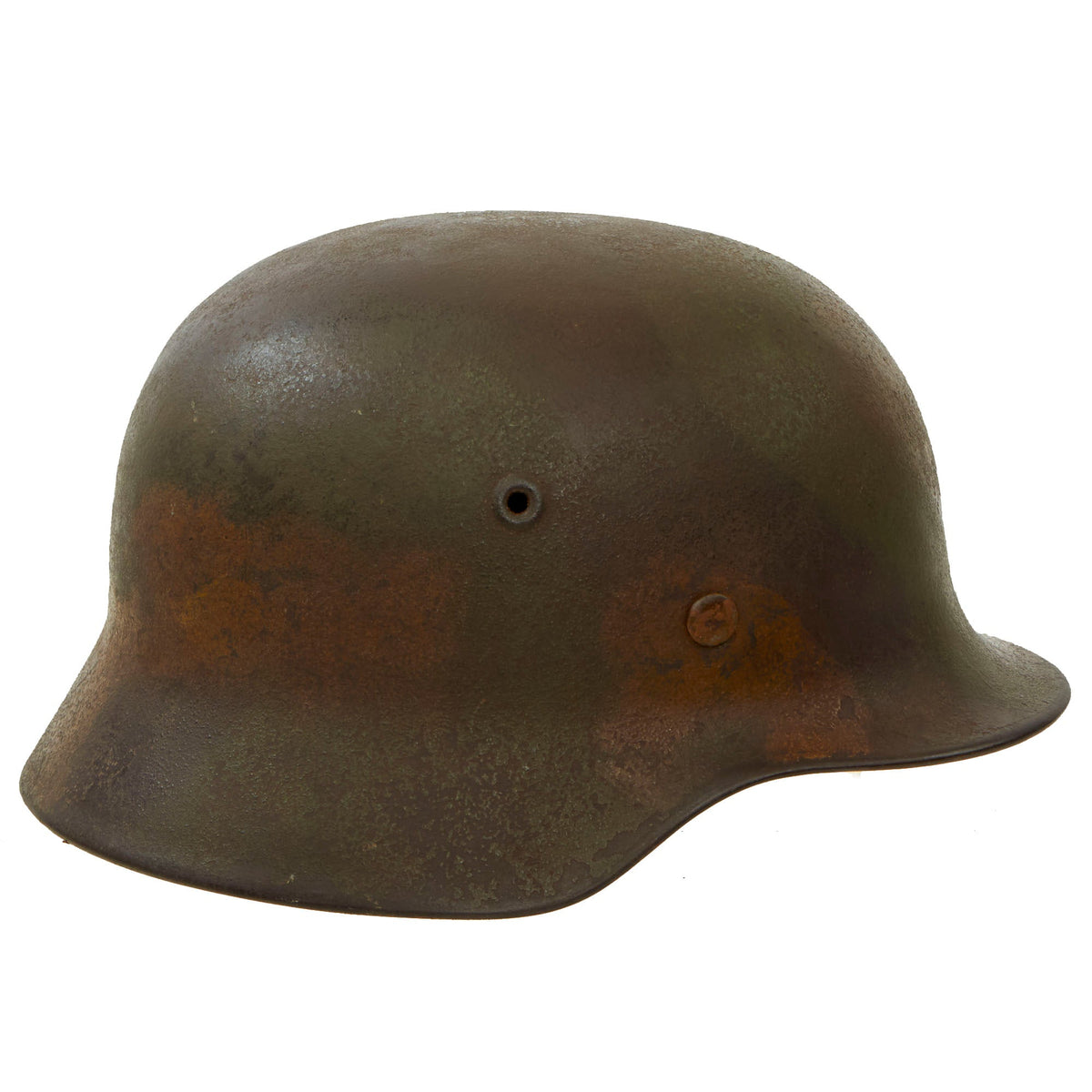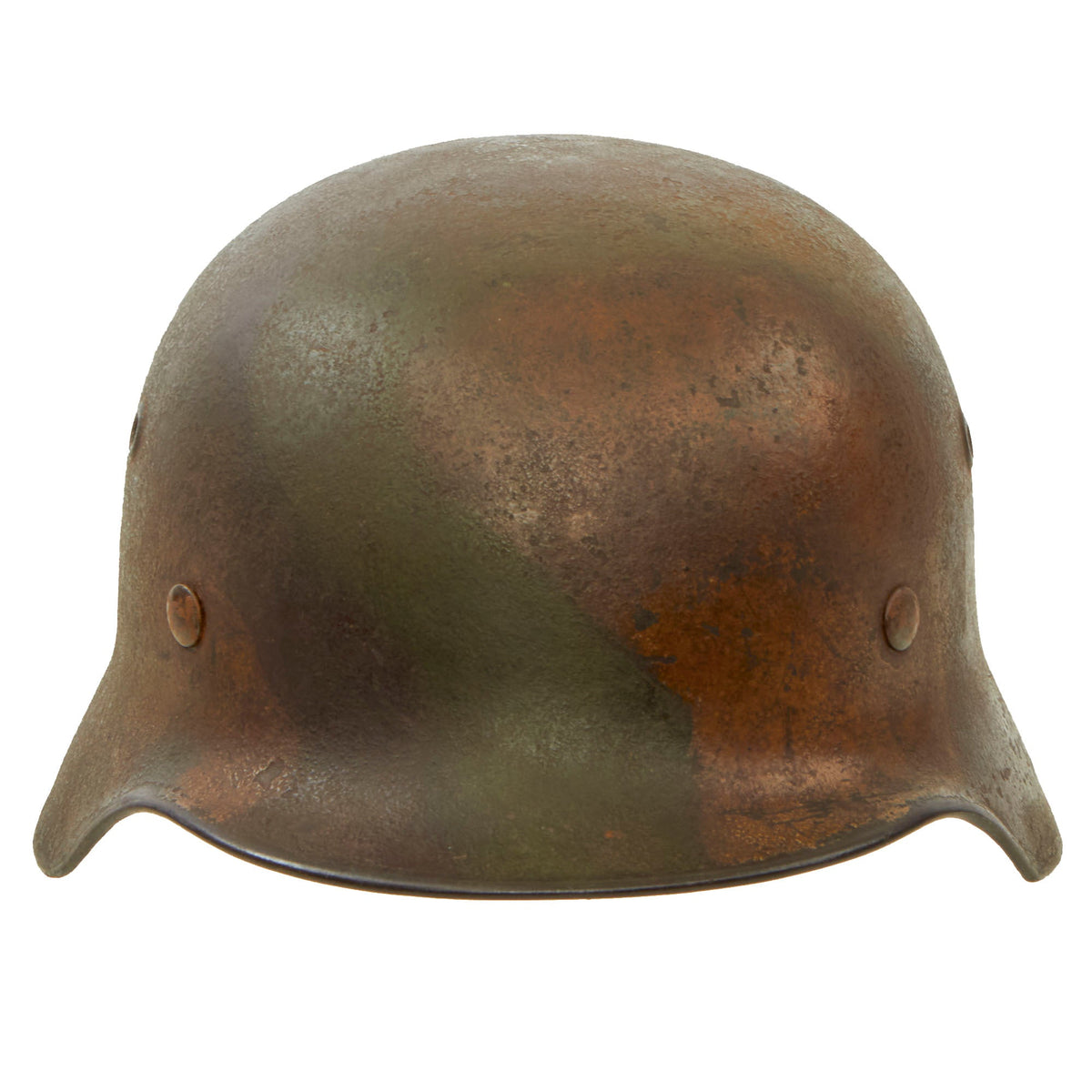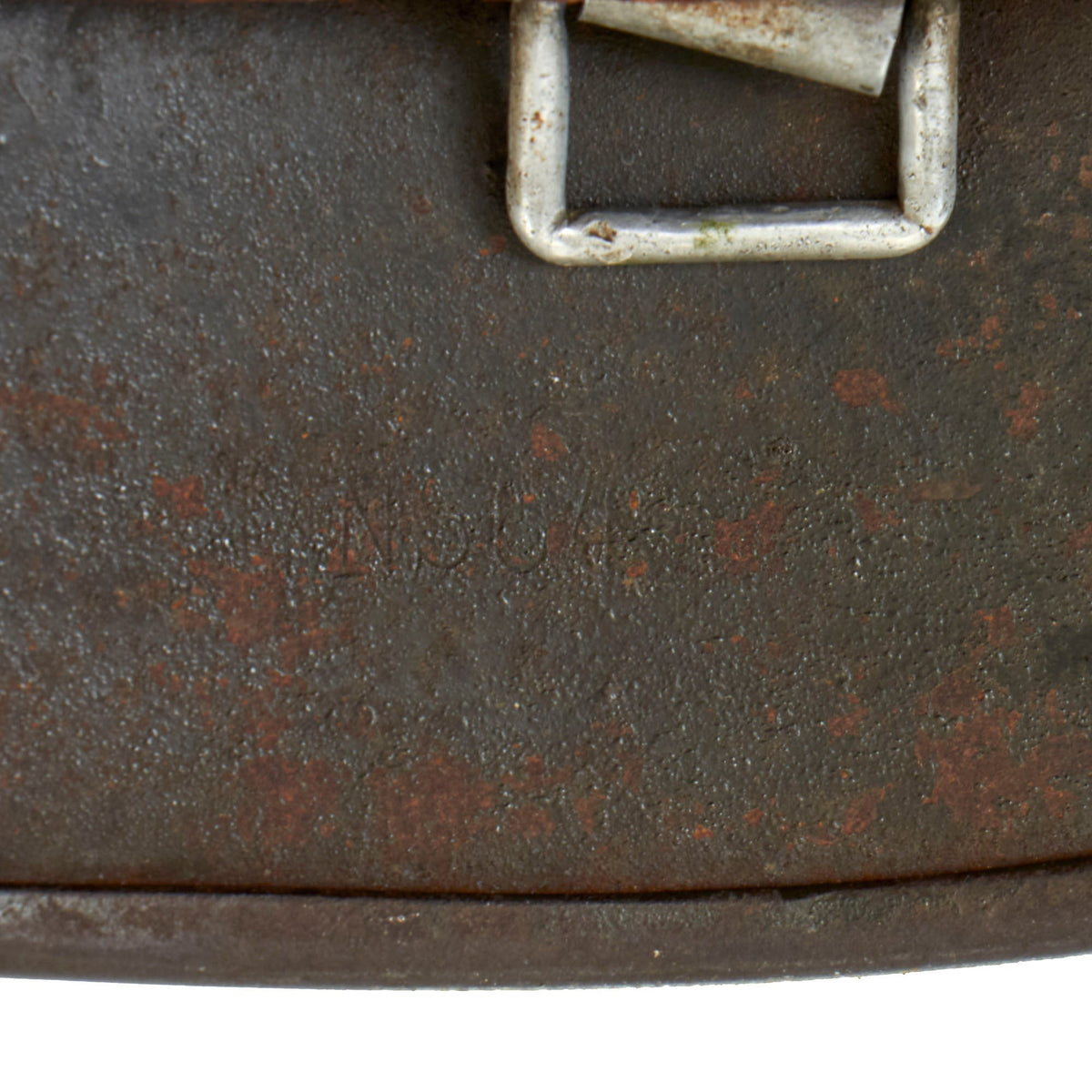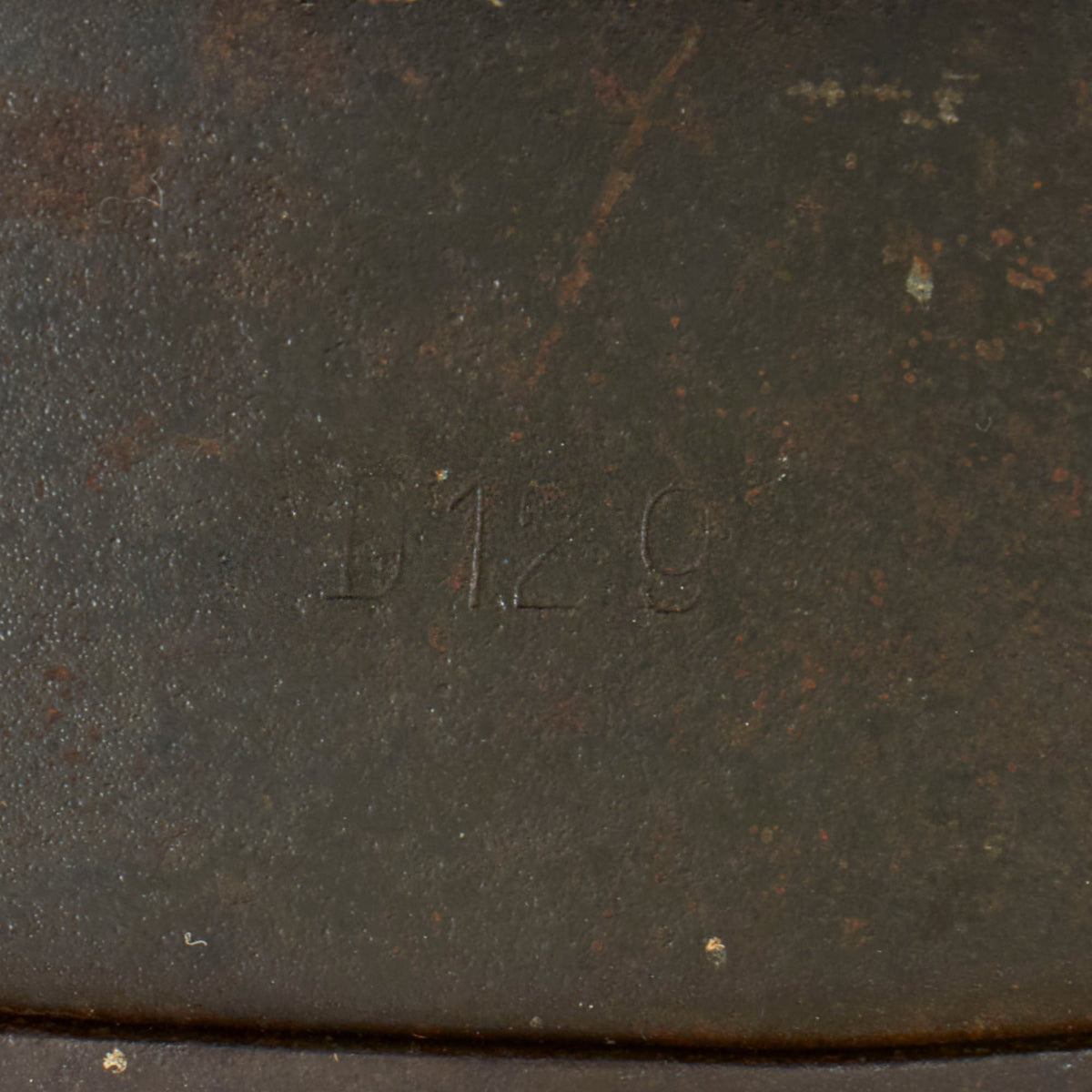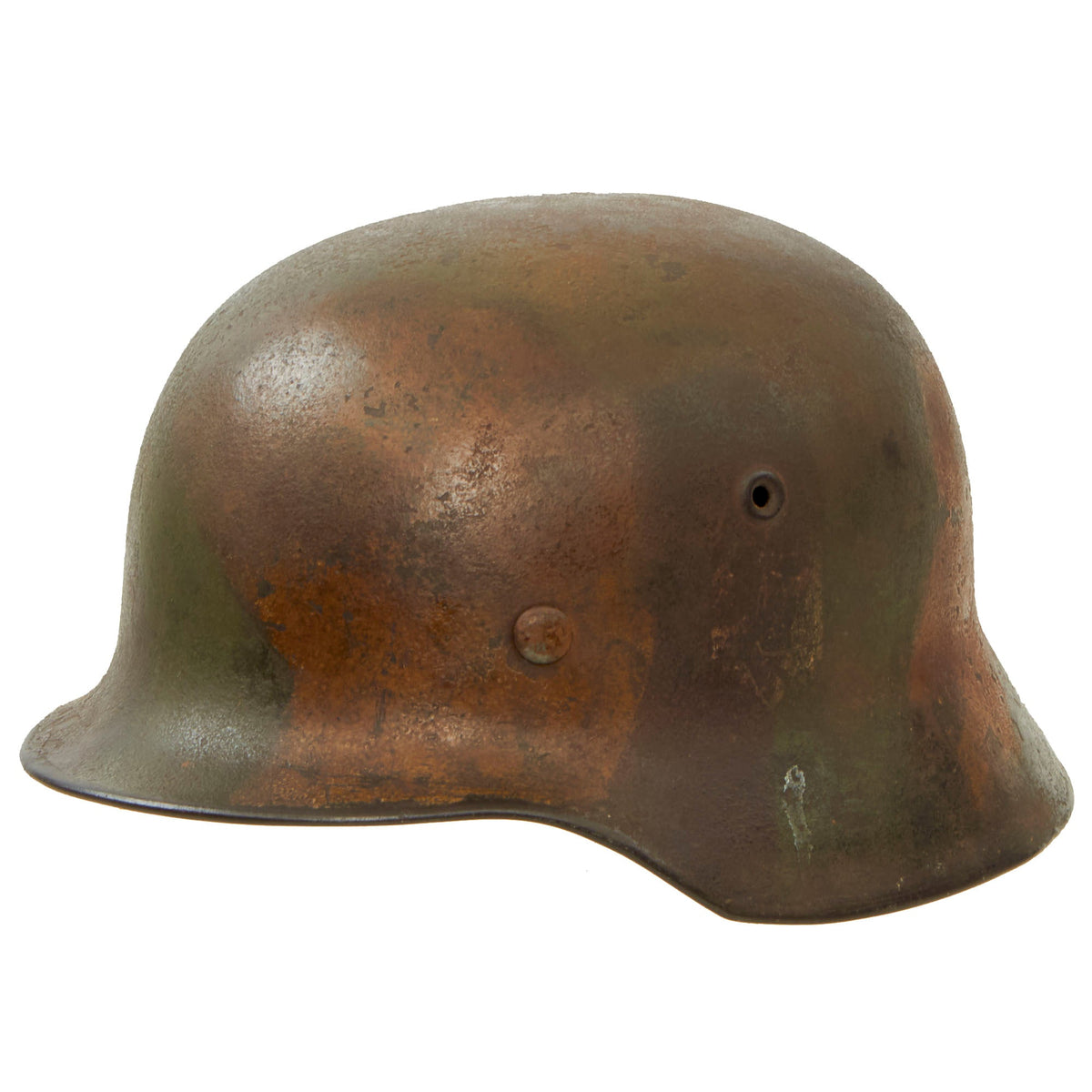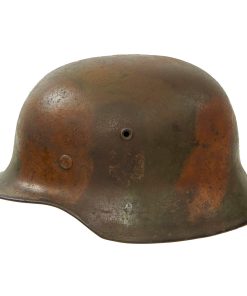Original German WWII Army Heer M40 No Decal “Normandy” Camouflage Steel Helmet with 57cm Liner – marked NS64 Original Items
$ 2.895,00 $ 723,75
Original Item: Only One Available. This is a fantastic all original example of a Model 1940 German WWII helmet as issued to the Heer (Army), with a great service worn look. It looks like it may have had originally been a “Single Decal” helmet with a Heer eagle decal on the left side, but now all that is visible is a bit of an outline of where it was. The shell a lovely period applied tan, brown, and green camouflage paint job, which is the very desirable “Normandy Pattern”! This was most likely applied over the original worn panzergrau paint, and period wear has given it a great patinated look that is simply impossible to duplicate!
The reverse, interior, neck guard apron is lot number stamped D129 and the interior, left side, apron has the stamped manufacturer’s code and size NS64, indicating that it was manufactured by Vereinigte Deutsche Nikelwerke, of Schwerte, Germany. Size 64 is a nice medium size that can accommodate liners from 56cm to 57cm or US 7 to 7 1/8. Size 64 shells are harder to find and are therefore more valuable to a collector. There is also the abbreviation Sch. A. under the rear skirt in white paint, probably for the owner of the helmet.
All three liner retaining pins are intact, with much of their original camouflage paint as well. The interior of the helmet still has an original M31 leather liner with all eight fingers still present and mostly intact, as well as an original top tie. The leather has a lovely color and worn look, with some earing and missing leather around the edge. There is also some tearing of the fingers themselves, so this is definitely a liner that saw real use in the field. The left side exterior of the galvanized steel liner band is marked 64 n.A / 57, indicating that it is a size 57 liner for a size 64 shell. The right side displays the full manufacture information, as well as a date, though it is a bit faint:
Metall-Lederverarbeitung W.Z.
1941
Bln.- Ch’burg 5
This indicates production by the metal and leather working company Werner Zahn, based in Berlin – Charlottenburg, in the year 1941, which fits right into the early war period, plenty of time for it to be repainted while deployed in Normandy.
Overall a stunning Normandy Camouflage Heer M40 Helmet offered in fantastic condition! Completely honest and with no signs of being messed with! We do not get helmets like these very often at all, and it is sure to appreciate in value in the coming years. Ready to display!
German WWII “Normandy” Camouflage:
Some of the most unique German helmets of WWII were worn during the Battle for Normandy. The terrain of thick green hedgerows, rolling green meadows, golden fields and orchards created diverse but deadly battlefields; one that necessitated good helmet camouflage for survival. To help their helmets blend into this environment, German soldiers at Normandy used a wide range of paint, wire, cloth covers and other devices to this end. These men were often hardened, experienced combat veteran with experience in campaigns in Poland, France, Africa and the USSR. They knew from experience what worked and what didn’t, and the helmet they wore during the Normandy campaign reflected that.
One effective, although more permanent method of concealing the helmet was the use of camouflage paint. It is up to some debate exactly when this method began among German soldiers but by the time of the Normandy campaign it was widespread. In mid 1943 the German high command ordered that a three color camouflaged scheme of tan, green and brown be used in the painting of vehicles and other equipment. These same paints were used to camouflage helmets as well. While the high command did order specific color codes be used for consistency, the hues of tan, green, and brown can vary on original examples significantly. The mix of these tan, green, and brown colors were used by German troops at Normandy with such frequency that today collectors call almost any German helmet with a mix of these three colors “Normandy Camo”.
It should be clear that while the use of these three colors for camouflaging helmets was common, there was never a directive from the German military high command to paint helmets in this manor. No officially sanctioned “Normandy camo” existed. The collector term, Normandy camo can still be justified to a large degree. Photos from the battle as well as surviving original example with Normandy providence would indicate this particular camo pattern was a favorite of Germans during the campaign. The mix of the three colors was certainly a good choice for Normandy as the countryside does exhibit those same colors. That being said with much of Western Europe’s terrain looking so similar this same pattern would see action in other battles as well.
The camouflage paints used at Normandy do not confine themselves to distinct hues of tan, brown and green. Some helmets were painted with two colors or just one and sometimes with non-standard military paints that were probably locally sourced. Further complicating the matter, captured British, Soviet, French and Italian paints were all used to camouflage helmets at Normandy. The hue of these colors often deviate from the standard German military colors. The German soldiers who camouflaged their helmets were well aware of their surroundings and certainly were aware of what colors and patterns would blend into the terrain they would soon be fighting in. It is logical they would have chosen colored paint based the local area which would account for the variation.
The German Stahlhelm Steel Helmet
The first “modern” steel helmets were introduced by the French army in early 1915 and were shortly followed by the British army later that year. With plans on the drawing board, experimental helmets in the field, (“Gaede” helmet), and some captured French and British helmets the German army began tests for their own steel helmet at the Kummersdorf Proving Grounds in November, and in the field in December 1915. An acceptable pattern was developed and approved and production began at Eisen-und Hüttenwerke, AG Thale/Harz, (Iron and Foundry Works), in the spring of 1916.
These first modern M16 helmets evolved into the M18 helmets by the end of WWI. The M16 and M18 helmets remained in usage through-out the Weimar Reichswehr, (National Defence Force, Circa 1919-1933), era and on into the early years of the Third Reich until the development of the smaller, lighter M35 style helmet in June 1935.
The Luftwaffe pattern national eagle was originally introduced for wear by Fliegerschaft, (Pilot Base), personnel of the DLV, Deutscher Luftsportsverband, (German Air Sports Association), the clandestine, civilian, forerunner of the Luftwaffe on August 18TH 1934, and adopted for wear by the Luftwaffe on March 1ST 1935 along with the national tri-color shield for wear on the helmet.
The first pattern national eagle was utilized until a modified second pattern eagle was introduced in late 1936 or early 1937. Regulations of June 12TH 1940 discontinued the use of the national tri-color decal and further regulations of August 28TH 1943 abolished the national eagle decal and dictated that it was also to be removed from all helmets although the directives were not completely adhered to.
Fast Shipping with Professional Packaging
Thanks to our longstanding association with UPS FedEx DHL, and other major international carriers, we are able to provide a range of shipping options. Our warehouse staff is expertly trained and will wrap your products according to our exact and precise specifications. Prior to shipping, your goods will be thoroughly examined and securely secured. We ship to thousands clients each day across multiple countries. This shows how we're dedicated to be the largest retailer on the internet. Warehouses and distribution centres can be located throughout Europe as well as the USA.
Note: Orders with more than one item will be assigned a processing date depending on the item.
Before shipping before shipping, we'll conduct a thorough inspection of the items you have ordered. Today, the majority of orders will be delivered within 48 hours. The delivery time will be between 3-7 days.
Returns
The stock is dynamic and we cannot completely manage it because multiple stakeholders are involved, including our factory and warehouse. So the actual stock may alter at any time. It's possible that you may not receive your order once the order has been made.
Our policy is valid for a period of 30 days. If you don't receive the product within 30 days, we are not able to issue a refund or an exchange.
You can only return an item if it is unused and in the same state as the day you received it. You must have the item in its original packaging.
Related products
Uncategorized
Uncategorized
Armored Burgonet Helmet & Polearm from Scottish Castle Leith Hall Circa 1700 Original Items
Uncategorized
Uncategorized
Uncategorized
Uncategorized
Uncategorized
Uncategorized
Uncategorized
Uncategorized
Uncategorized
Uncategorized
Uncategorized

